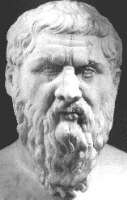Plato/The Structure of Human Knowledge

The Strucure of Human Knowledge
Since an ideal society will be ruled by those of its citizens who are most aware of what really matters, it is vital to consider how that society can best raise and educate its philosophers. Plato supposed that under the usual haphazard methods of childrearing, accidents of birth often restrict the opportunities for personal development, faulty upbringing prevents most people from achieving everything of which they are capable, and the promise of easy fame or wealth distracts some of the most able young people from the rigors of intellectual pursuits. But he believed that those with the greatest ability—that is, people with a natural disposition fit for philosophical study—must receive the best education, engaging in a regimen of mental discipline that grows more strict with every passing year of their lives.
The highest goal in all of education, Plato believed, is knowledge of the Good; that is, not merely an awareness of particular benefits and pleasures, but acquaintance with the Form itself. Just as the sun provides illumination by means of which we are able to perceive everything in the visual world, he argued, so the Form of the Good provides the ultimate standard by means of which we can apprehend the reality of everything that has value. (Republic 508e) Objects are worthwhile to the extent that they participate in this crucial form.
So, too, our apprehension of reality occurs in different degrees, depending upon the nature of the objects with which it is concerned in each case. Thus, there is a fundamental difference between the mere opinion (Gk. doxa [d#243;xa]) we can have regarding the visible realm of sensible objects and the genuine knowledge (Gk. episthmh [epist#234;m#234;]) we can have of the invisible realm of the Forms themselves. In fact, Plato held that each of these has two distinct varieties, so that we can picture the entire array of human cognition as a line divided proportionately into four segments. (Republic 509d)
At the lowest level of reality are shadows, pictures, and other images, with respect to which imagination (Gk. eikasia [eik#225;sia]) or conjecture is the appropriate degree of awareness, although it provides only the most primitive and unreliable opinions.
The visible realm also contains ordinary physical objects, and our perception of them provides the basis for belief (Gk. pistiV [p#237;stis]), the most accurate possible conception of the nature and relationship of temporal things.
Moving upward into the intelligible realm, we first become acquainted with the relatively simple Forms of numbers, shapes, and other mathematical entities; we can achieve systematic knowledge of these objects through a disciplined application of the understanding (Gk. dianoia [di#225;noia]).
Finally, at the highest level of all, are the more significant Forms—true Equality, Beauty, Truth, and of course the Good itself. These permanent objects of knowledge are directly apprehended by intuition (Gk. nohsiV [n#243;#234;sis]), the fundamental capacity of human reason to comprehend the true nature of reality.